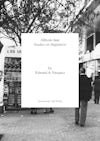Content
Agnes Martin’s Night Sea (1963) is a large canvas of hand-drawn rectangular grids painted in luminous blue and gold. In this illustrated study, Suzanne Hudson presents the painting as the work of an artist, thinker, poet and writer, for whom self-presentation was a necessary part of making works public.
With Night Sea, Hudson argues, Martin was moving from visible labour to lightness unburdened by evidence of process. She created a shimmering realisation of control and loss that stands alone within her suite of classic grid paintings as an exceptional achievement.
In her wonderful contribution to the Afterall Books One Work series, Suzanne Hudson persuasively argues that Agnes Martin’s 1963 painting Night Sea is the summa of the early grid paintings. Because, as Hudson shows, Night Sea makes Martin’s process – and indeed Martin’s struggle – so visible, we comprehend much more clearly what follows: the achieved perfection of the graphite grid paintings. That an analysis of a single work could so fully illuminate the entirety of an artist’s oeuvre is a true accomplishment. Plus, the prose is a pleasure to read.
– Douglas Crimp, 2017
This title is part of the One Work book series, which focuses on the artworks that have significantly shaped the way we understand art and its history.




